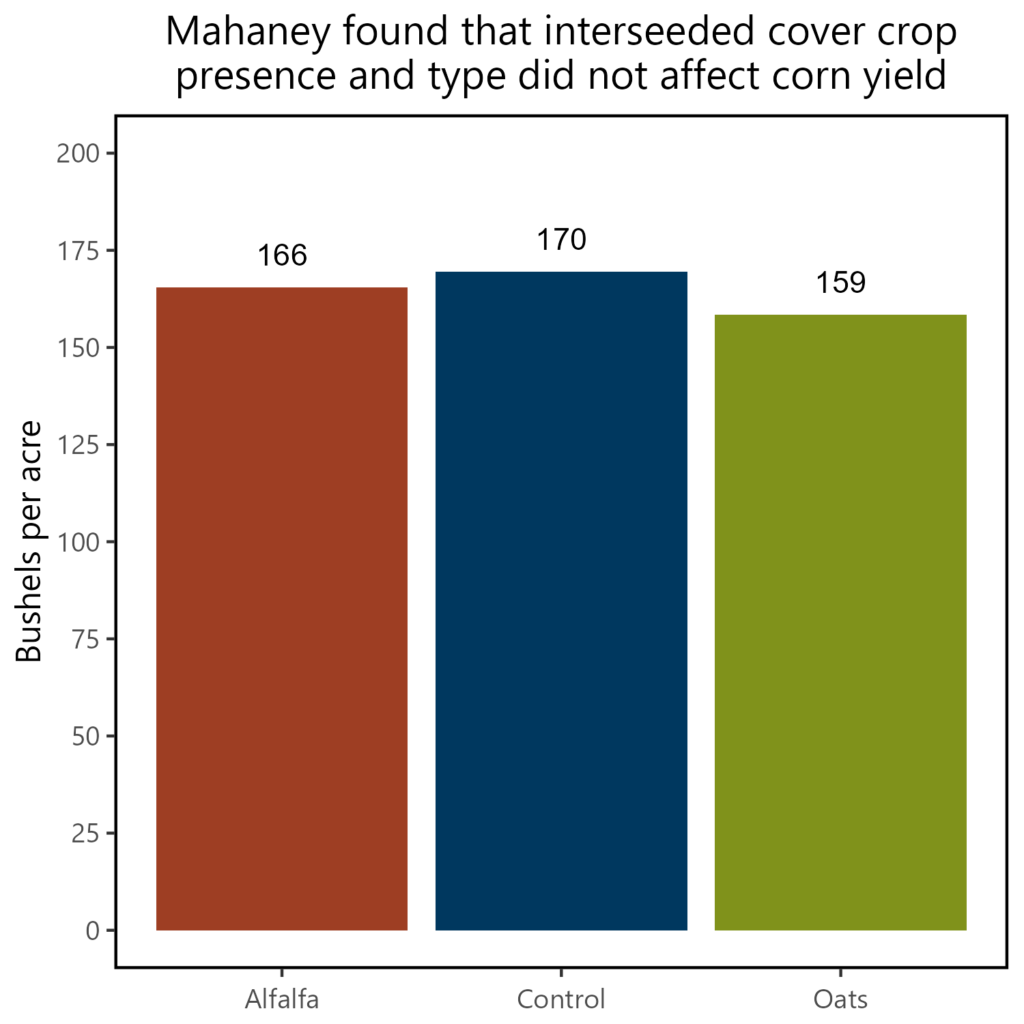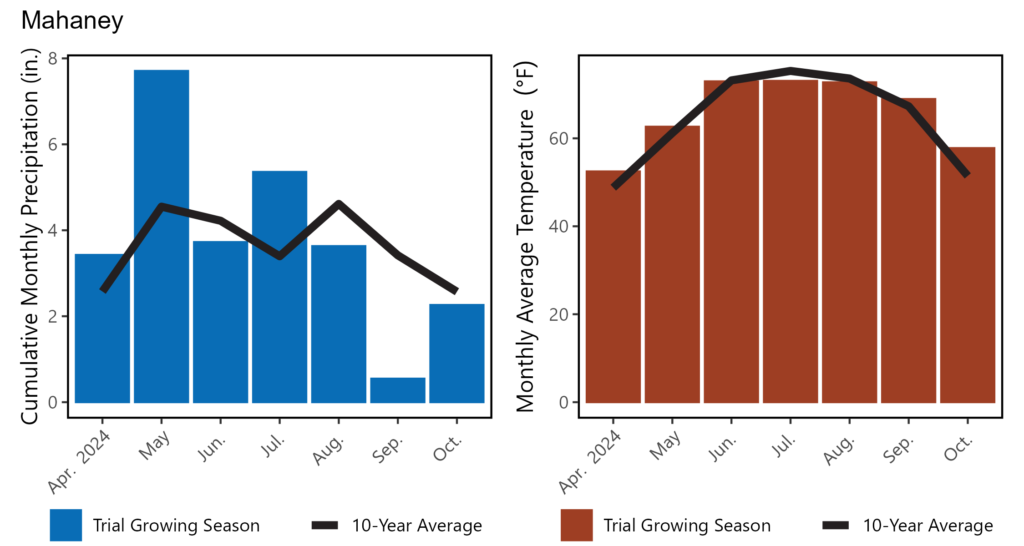This research was funded by USDA-NRCS.
In a Nutshell:
- Managing fall cover crop planting around soybean and corn harvest schedules is a major
barrier to successful cover crop establishment for many Iowa farmers. - Some farmers instead interseed cover crops into their standing crops before canopy
closure to give the cover crops an earlier start. - Eric Mahaney and Laban Miller conducted trials investigating how interseeded cover
crop type (Mahaney) and presence (both) affected cover crop biomass production and
corn yield.
Key Findings:
- Miller interseeded a diverse cover crop mix in late May but had very little germination,
likely due to residuals from a spring 2,4-D application. - Mahaney found no difference in corn yield between oat, alfalfa and control (no
interseeded cover) treatments. Alfalfa looked much better and yielded more biomass
(2.2 tons/ac) than oats (1.3 tons/ac). - Mahaney also had some establishment issues in his trial that affected corn and cover crop performance. Wet conditions required him to replant corn, prevented early season cultivation and caused washouts in some parts of the replanted field.
Background
All of the benefits that cover crops provide – feeding livestock, reducing soil erosion, suppressing weeds, increasing infiltration, enhancing nutrient cycling or fixing nitrogen, increasing soil organic matter – rely on biomass growth [1,2,3]. However, planting cover crops after corn or soybean harvest in Iowa leaves very little time for the plants to put on significant biomass before winter dormancy. Knowing this, farmers in Iowa cite planting timing as one of the major barriers that they face in successfully adopting cover crops [4].
Establishing cover crops by interseeding them into standing corn or soybeans early in the summer is one potential solution that extends the cover crop growing season. Interseeding usually involves planting covers into inter-row spaces when the cash crops are still small, but some farmers also fly on cover crop seed a bit later in the season. Though timing of interseeding around cash crop maturity is tricky and germination or growth can be poor in dry years, farmers hope that in a good year, interseeding covers may lead to significant fall biomass growth [4]. However, many farmers worry that interseeding cover crops could affect their cash crop yield and want to know that the practice pays off with increased biomass.
PFI farmers have conducted over a dozen research trials on interseeding cover crops in corn and soy systems in the past decade [5-15]. This research demonstrated that interseeding covers in corn at V4-V6 stage does not usually negatively affect corn yield, but interseeding earlier might, and increasing corn row widths to allow for more light for the covers almost certainly will. This year, PFI farmers Laban Miller and Eric Mahaney continued the research and conducted trials investigating how interseeded cover crop type (Mahaney) and presence (both) affected cover crop biomass production and corn yield. Both farmers are motivated to maximize cover crop growth because they believe it will positively impact their farm economics and environmental health.
Methods
Design
Miller planted corn on 60-in. row spacing. On April 30, he interseeded a diverse cover crop mix containing brown flax (2 lb/ac), impact forage collards (2 lb/ac), Kentucky Pride crimson clover (1 lb/ac), Mancan buckwheat (3 lb/ac), Sunn hemp (3 lb/ac), Trophy Rapeseed (1 lb/ac) and purple top turnips (1 lb/ac).
Mahaney planted corn on 30-in. rows and interseeded cover crops in three treatments: oats (10 lb/ac), alfalfa (8 lb/ac) and control (no cover crop). He interseeded the cover crops 44 days after corn planting after about 558 growing degree days had accumulated [16]. Planting and management details are presented in Table 1. Mahaney established treatments in randomized, paired strips: 3 treatments x 4 replications = 12 strips total (Figure A1).
Measurements
Mahaney recorded grain yield and moisture using a yield monitor or weigh wagon. Reported corn yields are corrected to 15.5% moisture. Mahaney also documented costs of equipment passes and seed.
Data analysis
To evaluate whether interseeding cover treatment affected corn, we conducted a two-way ANOVA that accounts for treatment and replicate location at the 95% confidence level. We followed the ANOVA with a Tukey’s test which produces an Honest Significant Difference (HSD) statistic. If the difference in corn yield between any two treatments was greater than the HSD, we say that the treatment significantly affected yield. We would expect such a difference to occur 95 times out of 100 under the same conditions. On the other hand, if the resulting difference between the two treatments was less than the HSD, we would say that the treatment did not affect corn yield. We can perform this analysis because Mahaney planted a completely randomized and replicated experiment (Figure A1).
Results and Conclusions
Miller was unable to complete the trial because of poor cover crop germination. He had previously applied 2,4-D to his field, which he believes is the reason for the germination failure. While he now has a plan for how he can manage his preplant herbicide treatments to allow for cover crop germination, he reflects that a major challenge remains: how can he manage weeds in the mid-season while allowing cover crops to grow. Other farmers have suggested that some grass cover crops may allow farmers to use some herbicides, or that planting on 60-in. rows may allow for later cover crop interseeding.
Mahaney found that interseeding alfalfa and oat into his standing corn did not significantly affect corn yield compared to a control treatment (Figure 1). While he did not weigh biomass samples of the cover crop from each if his treatment replicates, he did observe that alfalfa gathered from several areas of the trial averaged 2.2 tons/ac while oat straw averaged 1.3 tons/ac. The alfalfa definitely seemed to be doing better than the oats after corn harvest. However, alfalfa seed cost him $40/ac to plant while oat cost only $3/ac.
Despite successful germination and some biomass accumulation, Mahaney does not consider the trial to be a fair assessment of interseeding as a practice because wet weather prevented early season cultivation and led to a much weedier than usual field. This weed pressure likely affected both corn and interseeded cover performance. He plans to repeat the trial and predicts that in a drier year he will see more biomass from interseeded alfalfa and oat cover crops.
Mahaney also plans to experiment with using cover crops for early season weed suppression by planting soybeans green into rye and planting corn into standing alfalfa. “I will be planting my cover crops in 30-in. rows during the fall and come back in the spring to plant my row crops between those rows. I believe this will have better weed management than waiting until after my main crop is growing (to plant covers).”

Figure 1. Corn yields as affected by interseeding oat or alfalfa cover crops at Eric Mahaney’s in 2024. Because none of the treatments differed by more than the honest significant difference (HSD = 15 bu/ac), we considered the results statistically similar at the 95% confidence level.
Appendix – Trial Design and Weather Conditions

Figure A1. Example of experimental design used Mahaney which included randomized replicated interseeding cover crop treatments. This design allowed for statistical analysis of the results.

Figure A2. Modelled mean monthly temperature and rainfall at Mahaney’s during the study period and the ten-year historic averages. Data is from the NasaPOWER climate dataset [17, 18]
Funding Acknowledgment
This material is based upon work supported by the U.S. Department of Agriculture, under agreement number NR226114XXXXG004. Any opinions, findings, conclusions, or recommendations expressed in this publication are those of the author(s) and do not necessarily reflect the views of the U.S. Department of Agriculture. In addition, any reference to specific brands or types of products or services does not constitute or imply an endorsement by the U.S. Department of Agriculture for those products or services.
References
[1] F. Ardenti, F. Capra, M. Lommi, A. Fiorini, and V. Tabaglio, “Long-term C and N sequestration under no-till is governed by biomass production of cover crops rather than differences in grass vs. legume biomass quality,” Soil Tillage Res., vol. 228, p. 105630, Apr. 2023, doi: 10.1016/j.still.2022.105630.
[2] V. Nichols, R. Martinez-Feria, D. Weisberger, S. Carlson, B. Basso, and A. Basche, “Cover crops and weed suppression in the U.S. Midwest: A meta-analysis and modeling study,” Agric. Environ. Lett., vol. 5, no. 1, p. e20022, 2020, doi: 10.1002/ael2.20022.
[3] K. Koudahe, S. C. Allen, and K. Djaman, “Critical review of the impact of cover crops on soil properties,” Int. Soil Water Conserv. Res., vol. 10, no. 3, pp. 343–354, Sep. 2022, doi: 10.1016/j.iswcr.2022.03.003.
[4] G. E. Roesch-Mcnally et al., “The trouble with cover crops: Farmers’ experiences with overcoming barriers to adoption,” Renew. Agric. Food Syst., vol. 33, no. 4, pp. 322–333, 2018, doi: 10.1017/S1742170517000096.
[5] E. Link and N. Wendt, “Interseeding Cover Crops in Corn,” Practical Farmers of Iowa, 2023. [Online]. Available: https://practicalfarmers.b-cdn.net/wp-content/uploads/2024/04/23.FC_.InterseedCCtoCorn.pdf
[6] S. Gailans, J. Boyer, and D. Sloan, “Interseeding Cover Crops to Corn,” Practical Farmers of Iowa, 2022. Accessed: Jul. 20, 2023. [Online]. Available: https://practicalfarmers.org/research/interseeding-cover-crops-to-corn/
[7] S. Gailans, “Interseeding Cover Crops to Corn in Early Summer,” Practical Farmers of Iowa, 2020. [Online]. Available: https://practicalfarmers.org/research/interseeding-cover-crops-to-corn-in-early-summer/
[8] S. Gailans and J. Boyer, “Interseeding Cover Crops in Seed Corn at the V4-V6 Stage,” Practical Farmers of Iowa, 2017. [Online]. Available: https://practicalfarmers.org/research/interseeding-cover-crops-in-seed-corn-at-the-v4-v6-stage/
[9] S. Gailans and J. Van Horn, “Interseeding Cover Crops to Corn and Soybeans,” Practical Farmers of Iowa, 2022. [Online]. Available: https://practicalfarmers.org/research/interseeding-cover-crops-to-corn-and-soybeans/
[10] S. Gailans, L. Brown, and T. Sieren, “Planting Corn in 60-in. Row-Widths for Interseeding Cover Crops,” Practical Farmers of Iowa, 2021. [Online]. Available: https://practicalfarmers.org/research/planting-corn-in-60-in-row-widths-for-interseeding-cover-crops-4
[11] S. Gailans et al., “Planting Corn in 60-in Row-Widths for Interseeding Cover Crops,” Practical Farmers of Iowa, 2018. [Online]. Available: https://practicalfarmers.org/research/planting-corn-in-60-in-row-widths-for-interseeding-cover-crops/
[12] S. Gailans, F. Abels, N. Anderson, J. Olson, T. Sieren, and M. Yoder, “Planting Corn in 60-in. Row-Widths for Interseeding Cover Crops,” Practical Farmers of Iowa, 2020. [Online]. Available: https://practicalfarmers.org/research/planting-corn-in-60-in-row-widths-for-interseeding-cover-crops-3/
[13] S. Gailans et al., “Planting Corn in 60-in. Row-Widths for Interseeding Cover Crops,” Practical Farmers of Iowa, 2019. [Online]. Available: https://practicalfarmers.org/research/planting-corn-in-60-in-row-widths-for-interseeding-cover-crops-2/
[14] S. Ose and S. Gailans, “Interseeding Date for Cereal Rye Cover Crop in Seed Corn,” Practical Farmers of Iowa, 2019. [Online]. Available: https://practicalfarmers.b-cdn.net/wp-content/uploads/2019/11/19.FC_.CC.Interseeding-Date-Cereal-Rye-Seed-Corn.pdf
[15] S. Gailans, F. Abels, and C. Teachout, “Co-Seeding Legumes with Corn,” Practical Farmers of Iowa, 2018. [Online]. Available: https://practicalfarmers.org/research/co-seeding-legumes-with-corn/
[16] A. DeGaetano, R. Moore, B. Belcher, and B. Eck, “CSF Growing Degree Day Calculator.” 2016. [Online]. Available: https://climatesmartfarming.org/tools/csf-growing-degree-day-calculator/
[17] A. H. Sparks, “nasapower: A NASA POWER Global Meteorology, Surface Solar Energy and Climatology Data Client for R,” J. Open Source Softw., vol. 3, no. 30, p. 1035, Oct. 2018, doi: 10.21105/joss.01035.
[18] A. H. Sparks et al., nasapower: NASA POWER API Client. (May 18, 2024). Accessed: Sep. 11, 2024. [Online]. Available: https://cran.r-project.org/web/packages/nasapower/index.html


